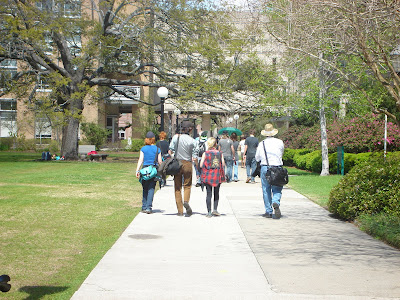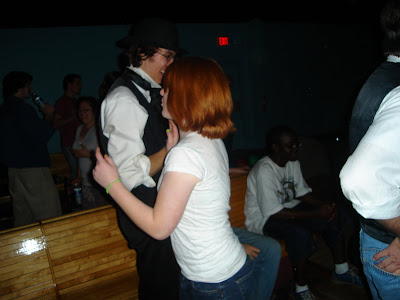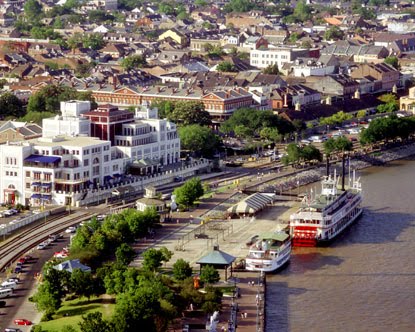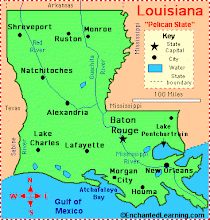On wednesday, our third day in, we set out bright and early in a van to tour the creol plantations along the Mississippi upriver from New Orleans. Our guide took us along the historic river road and filled us in with an excellent account of the history of the plantaion system in Louisiana as well as insights into the geography of plantation boundaries and the architectural history represented in the old plantation buildings.
Our first stop was Oak Alley, named after the splendid oak lined entry road. Here is Christopher examining the lock to the front entry.
Directly across from this gate and the Alley of Oaks is the levee of the Mississippi. All of the plantations we saw were arranged so that they faced the river, the most reliable source of transportation and also a source of fresh cool air, which the oaks in the picture above were designed to funnel into the great house to help cool it.
Here is our whole group, staff included, on the river bank just above Oak Alley.
And what follows are a few miscillaneous shots of the river itself.
And the historical marker with part of the Oak Alley story
The discrepancy between the age of the house and that of the alley of oaks is due to the fact that the present Greek Revival big house replaced the traditional Creol style big house long after the first owners had abandoned the plantation.
Here again is our entire crew, courtesy of our guide, this time posed in front of the famous alley of oaks.
What follows is a photo of the alley looking back towards the Mississippi from the second floor gallery of the plantation.And a shot of some of our travellers lounging on the gallery.
Here is a shot of the formal gardens outside of Oak Alley.

Next we moved on to Evergreen Plantation. Its big house is a modified Creol design which still retains a lot of the features of the original Creol style with it's hipped roof and surrounding gallery, but with an overlay of greek revival applied by subsequent owners and with the original elevated pylon construction (a flood-defensive measure) obscured by the addition of a walled in storage area on the lower floor. The graceful starecase was also a later addition.
Here's a view looking towards the river of the huge spanish-moss covered oaks in the front yard of Evergreen Plantation.

Another view of the front of Evergreen with the pigionnier in the background, used to provide squab for the tables of the great house and eggs.
Entering the great house we took a few shots of the interior.
After visiting the great house we were then led out to the business end of the plantation for a look at the double row of slave quarters used to house slaves who worked the sugar-cain fields.

This inventive leaning chair caught my eye.
On our way back our students encountered some extremely friendly kittens which absorbed their attentions and affections. As you can tell, the cats were as pleased as our students were.
On the outskirts of Evergreen Plantation we also ran into some longhorn cattle.
After this we piled back into the car, crossed the river and were driven back along the shores of Lake Pontchartrain into the French Quarter where we revisited Johnny's Po'boys for a delicious lunch.



























































